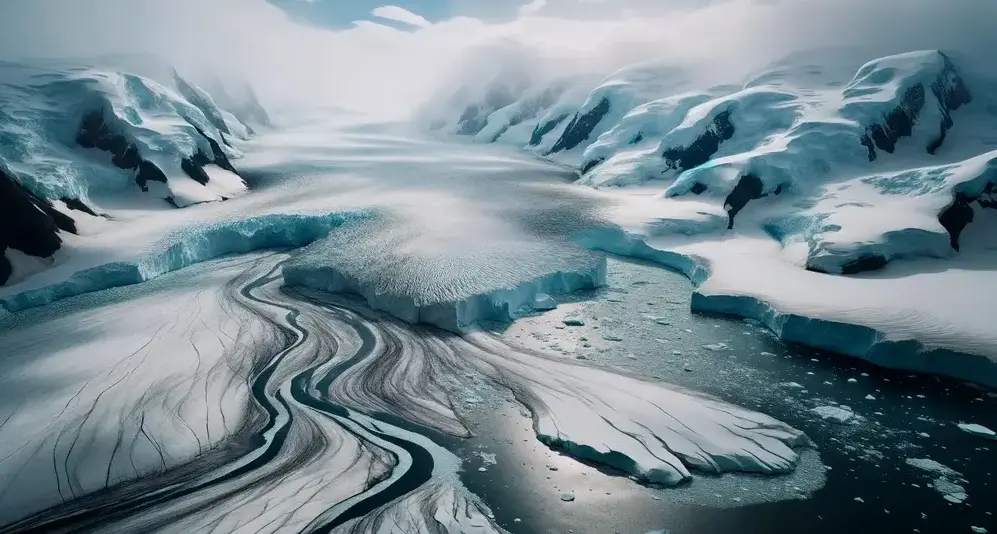As the Arctic warms, rising rivers could release carbon emissions equivalent to those of millions of vehicles. Recent discoveries at Dartmouth provide groundbreaking evidence that Arctic permafrost significantly impacts the region’s river systems. This study published Proceedings of the National Academy of SciencesIt highlights how permafrost, a dense layer of soil that remains frozen for at least two years, causes rivers in the Arctic to flow through narrower, shallower valleys than their southern counterparts.
But permafrost is also an increasingly fragile reservoir containing large amounts of carbon. As climate change weakens the permafrost in the Arctic, researchers estimate that every 1.8 degrees Fahrenheit (1 degree Celsius) of global warming could release as much carbon as 35 million cars a year as polar waterways expand and churn up thawing soil.
Landscape dynamics and research motivation
“The entire Earth’s surface is a tug of war between processes like hills that flatten landscapes and forces like rivers that tear them apart,” said lead author Joanmarie Del Vecchio, who led the study as a Neukom Postdoctoral Fellow. Dartmouth, along with his advisors and co-authors of the study, Marisa Paluchis, associate professor of earth sciences, and Colin Meyer, professor of engineering.
“We understand the physics at a basic level, but when things start to freeze and thaw, it’s hard to predict which side will win,” Del Vecchio said. “If the hillsides win, they will bury all the carbon that enters the soil. But if the situation heats up and river beds suddenly start to prevail, we will see a lot of carbon being released into the atmosphere. “It’s likely to create this warming feedback loop that will lead to the emission of more greenhouse gases.”
The researchers set out to understand why Arctic watersheds (the total catchment area of a river and its associated waterways) tend to have a smaller river area than watersheds in warmer climates; these basins can have large tributaries that spread across the landscape. Del Vecchio, now a visiting scholar at Dartmouth and an associate professor at the College of William and Mary, conceived the study while doing field research in Alaska in 2019. He walked uphill from his riverside workplace and took in the view of steep mountain slopes undisturbed by rivers or streams.
“It looked like the slopes won and the channels lost,” Del Vecchio said. “We wanted to test whether temperature was shaping this landscape. We’re very fortunate to get as much surface data and digital elevation data as we have in the last few years. We couldn’t have done this research a few years ago.”
Research results and analysis
Using satellite and climate data, researchers examined the depth, topography, and soil conditions of more than 69,000 basins in the Northern Hemisphere (from the Tropic of Cancer to the Arctic). They measured the percentage of land occupied by each river’s canal network within its catchment, as well as the steepness of river valleys.
Forty-seven percent of the watersheds analyzed consist of permafrost. Compared to temperate basins, river valleys are deeper and steeper, and channels cover approximately 20% less of the surrounding land. These similarities exist despite differences in glacial history, background topographic steepness, annual precipitation, and other factors that would control the push and pull of water and soil, the researchers note. Arctic basins are formed thanks to a common feature: permafrost.
“No matter how we cut it, regions with larger and more abundant river channels are warmer, have higher average temperatures, and have less permafrost,” del Vecchio said. “You need a lot more water to form valleys in permafrost regions.”
Permafrost’s ability to limit the footprint of Arctic rivers also stores large amounts of carbon in the frozen ground, according to the research. To estimate the amount of carbon that will be released from these basins due to climate change, the researchers combined the amount of carbon stored in permafrost with the soil erosion that would result from thawing and leaching of soil as Arctic rivers spread out.
Effects of climate change and concerns about the future
Del Vecchio said research shows the Arctic has warmed by more than 3.6 degrees Fahrenheit (2 degrees Celsius) compared to pre-industrial levels, or since about 1850. Scientists estimate that the gradual melting of permafrost in the Arctic could release between 22 billion and 432 billion tons of carbon dioxide by 2100 if current greenhouse gas emissions are reduced, and up to 550 billion tons if not reduced. The International Energy Agency predicts that by 2022, energy consumption will result in the release of more than 36 billion tonnes of carbon dioxide into the atmosphere, an all-time high.
Paluchis, whose research team used the Arctic as an alternative, said the Arctic has adapted to cold for so long that scientists have no idea how much or how quickly carbon would be released if permafrost melted on an accelerated time scale. Studying processes on the surface of the Red Planet, Mars. “While there has been warming in the Arctic in the past, it’s scary how fast it’s happening now. The environment needs to react quickly, and that can be traumatic,” he said.
Paluchis recalled that on a research trip to the Arctic, he saw a boulder the size of a small building on a cliff. The cause of the split was a small stream of water seeping into the rock and weakening it.
“This landscape is adapted to colder conditions, so even a small amount of water flowing through the rock when you change it is enough to cause significant changes,” Paluchis said. said.
“Our understanding of Arctic landscapes is about the same as our understanding of temperate landscapes 100 years ago,” he said. “This study is an important first step in showing that the models and theories we have for temperate watersheds cannot be applied to polar regions. There is a whole new set of doors to go through to understand these landscapes.”
Sediment cores collected in the Arctic show intense soil flow and carbon accumulation around 10,000 years ago, indicating a much warmer region than now, del Vecchio said. Today, regions such as Pennsylvania and the Mid-Atlantic United States, located south of the farthest reaches of the Ice Age glaciers, herald the future of the modern Arctic.
“We have some evidence from the past that a lot of sediment was dumped into the ocean during warming,” del Vecchio said. “And now we have a snapshot from our paper showing that the Arctic will get more water channels as it warms. But none of this is the same as saying, “This is what happens when you take a cold landscape and raise the temperature too quickly.” “I don’t think we know how it’s going to change.”













